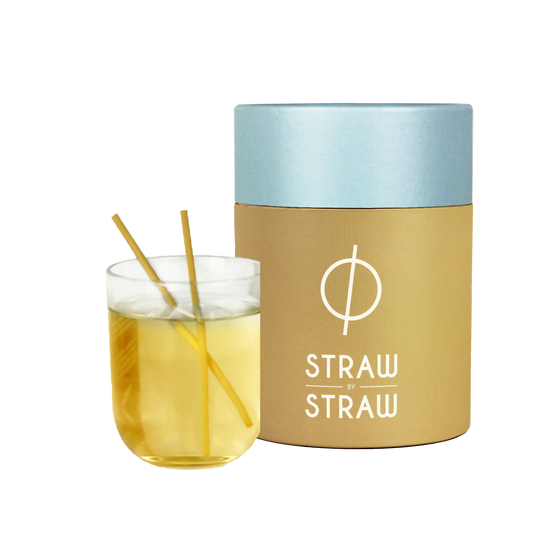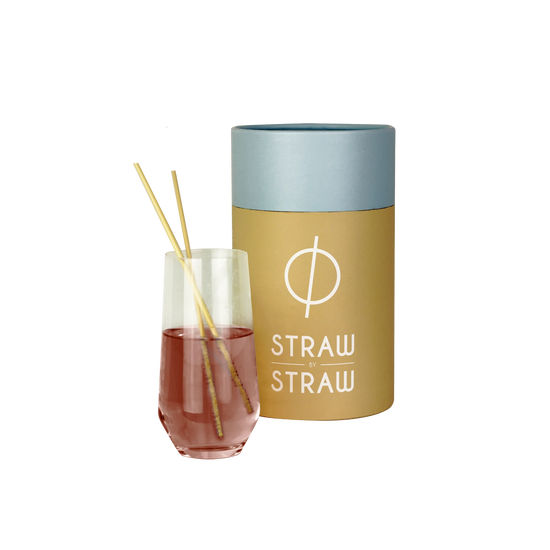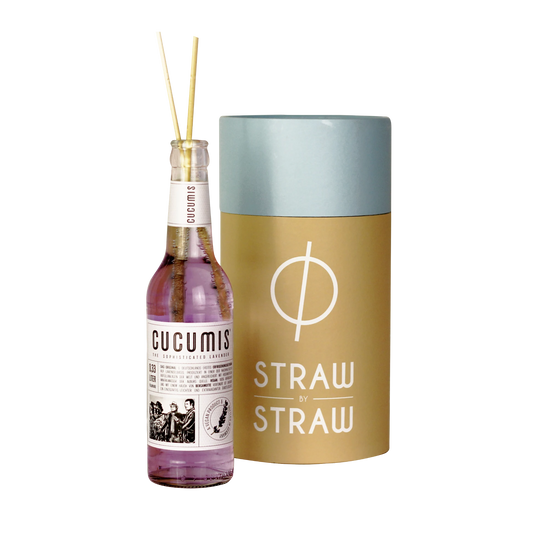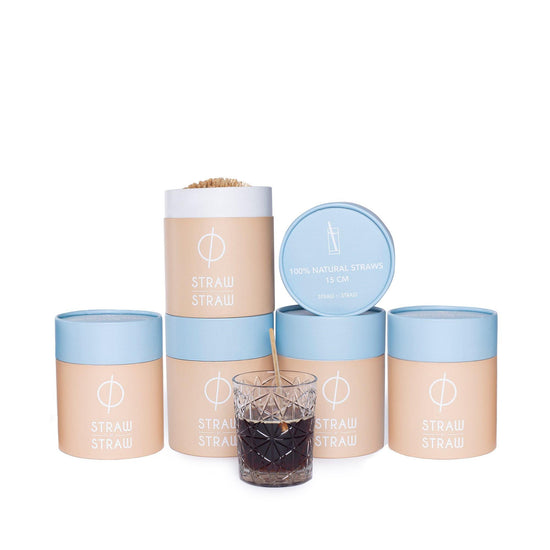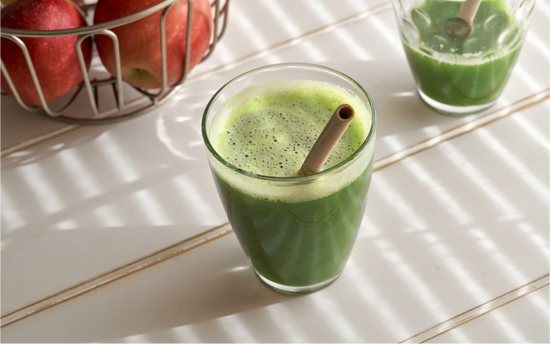Biodegradable straws are becoming increasingly popular as a sustainable alternative to plastic. They provide an eco-friendly solution for beverage consumption, without contributing to the growing problem of plastic pollution in our oceans and landfills. In this blog post, we’ll explore what biodegradable straws are, why they’re important, the different types available on the market today and their challenges and limitations. Join us on this journey towards a more sustainable future!
(check out our collection of Reed Straws and Wheat Straws here).
What are biodegradable straws?
Biodegradable straws are an eco-friendly and sustainable alternative to traditional plastic straws. Made from materials like bamboo, reed or wheat, these compostable straws break down naturally in the environment without causing harm to wildlife or polluting our oceans.
Unlike plastic straws that can take hundreds of years to decompose, biodegradable reed straws only take a few months. They work by breaking down into natural substances through biological processes such as composting, leaving no trace behind. (There are several kinds of biodegradable straws. As we strive to be the most sustainable straw brand, we only offer 100% natural straws made of the stems of plant).
With increasing concern about the impact of single-use plastics on the environment, biodegradable options like these offer a way forward towards more sustainable living practices.
Definition
Biodegradable straws are environmentally friendly alternatives to traditional plastic straws. These products are designed to break down naturally over time, reducing the amount of waste that ends up in landfills and oceans.
Here are some key points about biodegradable straws:
- They differ from compostable straws, which require special conditions to break down.
- Biodegradable materials can come from a variety of sources, such as sugarcane, cornstarch or paper pulp.
- PLA is a common material used for making biodegradable straws. However watch out: PLA does need certain industrial facilities for biodegradation.
Switching to biodegradable options is an important step towards sustainability and reducing our impact on the environment. By using these types of products, we can help reduce the amount of plastic waste that goes into our landfills and oceans while still enjoying convenient items like drinking straws.
How do they work?
Biodegradable straws are made from materials that can break down naturally in the environment. The breakdown process of these compostable straws usually involves microorganisms breaking them down into smaller pieces over time. However, several factors can affect the rate at which they decompose, such as temperature and moisture levels.
Biodegradable straws can be composted along with other organic waste and should not be thrown in traditional recycling or general waste bins.
When it comes to disposing of biodegradable straws, composting is a suitable method. Some companies claim that PLA-based straws can be added to organic waste and left to decompose along with other food scraps. However not in all countries are waste companies able to facilitate this because PLA could slow down the decomposing process.
Another option is industrial composting facilities that use controlled conditions to speed up decomposition rates for larger quantities of biodegradable materials. But also here, when you add PLA to organic waste, the organic waste decomposes much faster than PLA. It's definitely important not to throw PLA in traditional recycling bins or general waste bins as this could contaminate existing plastic streams and complicate the recycling process further.
Why are biodegradable straws important?
Plastic straws have a significant environmental impact, contributing to pollution and harming marine life. Biodegradable straws provide a sustainable alternative that can break down naturally without causing harm. These eco-friendly options are becoming increasingly important as individuals and businesses make efforts to reduce their carbon footprint and protect the environment. By switching to biodegradable straws, we can help mitigate the damage caused by plastic waste while still enjoying our favourite beverages.
Environmental impact of plastic straws
Plastic straw statistics reveal their alarming contribution to pollution, with an estimated 8.3 billion plastic straws polluting our oceans every year. These small pieces of plastic waste take hundreds of years to break down and threaten marine life by entangling or choking them.
The negative impact of plastic straws extends beyond the ocean as well. The slow decay rate of these single-use items fills up landfills and harms soil quality, which in turn affects agriculture production. Biodegradable straws offer a sustainable solution that breaks down within months without any harm to the environment or wildlife. By switching to biodegradable alternatives, we can reduce our carbon footprint and ensure a cleaner future for generations to come.
Benefits of biodegradable straws
Biodegradable straws are becoming increasingly popular due to their sustainability and eco-friendliness. The use of renewable materials in manufacturing biodegradable straws makes them a more sustainable option than traditional plastic straws. Additionally, the biodegradability, compostability, and ease of disposal of these straws make them an attractive alternative.
The factors that make biodegradable straws sustainable include both the material used in production and their end-of-life cycle. Biodegradable straw manufacturers typically use natural materials such as corn starch or bamboo to create their products. These materials are renewable, meaning they can be replenished over time without harming the environment. Moreover, once disposed of properly, biodegradable straws break down naturally without emitting harmful pollutants into the environment - unlike traditional plastic alternatives which take hundreds of years to decompose fully.
In summary, using biodegradable straws offers numerous benefits compared to traditional plastic options: they're made from renewable resources; they're easy and safe to dispose of; and they don't harm the environment during production or after disposal. All these factors combine to show why it's important for us all to switch from conventional plastics towards much more environmentally-friendly alternatives like bios-degradeable ones!
Types of biodegradable straws
Paper straws are a popular alternative to plastic. They are made from sustainable materials such as trees, and they decompose easily without harming the environment. Although paper straws may not last as long as plastic ones, their biodegradability makes them an excellent choice for those who want to reduce their environmental impact.
Bamboo straws are another eco-friendly option that has gained popularity in recent years. Bamboo is a fast-growing plant that does not require pesticides or fertilizers to grow, making it an ideal material for making biodegradable straws. These straws are reusable and durable, which means they can be used multiple times before being disposed of properly in compost bins or landfill sites.
Paper straws
The manufacturing process of paper straws involves using food-grade materials and adhesives to create a durable and safe product. Paper straws are designed to withstand liquids for several hours, making them suitable for use in various settings, including restaurants, bars, and cafes. However, the shelf life of paper straws is generally shorter compared to plastic ones due to their paper nature. Most paper straws don't last more than 20 minutes.
Disposal methods for paper straws include composting or recycling. Composting can be done at home or by local waste management facilities that have commercial composting systems. Recycling requires separating the paper from any leftover liquid before placing it in a designated recycling bin. Proper disposal ensures that these sustainable alternatives do not end up contributing to environmental pollution but rather decompose naturally without causing harm to wildlife or ecosystems.
Reed straws
Sourcing and sustainability are key factors when it comes to choosing a biodegradable straw option. Reed straws are a great choice as they are renewable, organic and biodegradable. They also do not produce any harmful chemicals or by-products during the manufacturing process.
Cleaning and maintenance of reed straws is also very easy compared to other options such as paper or metal straws. Simply rinse them with warm water after use and they can be reused multiple times before being composted at the end of their life cycle. However for our reed straws, we advice to use them as a single use item because of hygiene reasons.
Price comparison with other options shows that reed straws may initially cost more than plastic alternatives but in the long run, they are actually more cost-effective because they last longer than paper straws AND improve your drink presentation. Reed straws make your drinks look elegant and sustainable! Plus, investing in sustainably sourced products supports environmentally conscious practices while helping reduce waste in landfills.
- Sustainably sourced
- Easy cleaning and maintenance
- More cost-effective in the long run
Wheat straws
Wheat straws are gaining popularity as a biodegradable and sustainable alternative to plastic straws. The Straw by Straw wheat straws are made from the stem of wheat plants, which makes them an eco-friendly option for those who want to reduce their carbon footprint.
Here's what you need to know about wheat straws:
- Suitability for different beverages: Wheat straws are suitable for hot and cold drinks such as smoothies, cocktails, iced tea or coffee.
- Composting potential: One of the biggest advantages of using wheat straw is its ability to break down naturally after use. This means that it can be composted along with other organic waste without harming the environment.
- Availability in various countries: Wheat is grown in many parts of the world including Europe, North America, Asia and Australia; therefore there is no shortage when it comes to supply.
Although wheat straws are 100% plasticless, one disadvantage is that they are not flexible meaning you can't bend them like some plastic straws. But by choosing wheat straws over plastic ones users contribute positively towards protecting our planet while still enjoying their favourite drink without any guilt.
Cornstarch straws
Cornstarch straws are a sustainable alternative to plastic straws due to their high biodegradability rate. However, compared to other options like paper, bamboo, or wheat straws, cornstarch straws break down much slower.
(check out our collection of Reed Straws and Wheat Straws here).
Challenges and limitations of biodegradable straws
Biodegradable straws are a promising solution to the plastic waste crisis, but they also come with their own set of challenges and limitations. One major challenge is the cost of producing these straws, which can be significantly higher than traditional plastic straws. This can make them less accessible for businesses looking to implement more sustainable practices while staying within budget constraints. However we did reach our goal to make the price of wheat straws as low as the price of paper straws!
Another limitation is the durability and functionality of some biodegradable straws. Some types may not hold up as well in certain beverages or may break down too quickly before use. Additionally, there may be concerns about hygiene if these products are reused or recycled incorrectly. It's important to carefully evaluate the practicality of different types of biodegradable straw materials. So choose wisely for your restaurant!
Conclusion
In conclusion, biodegradable straws are a sustainable alternative to plastic that offer numerous benefits for the environment. Reed straws and wheat straws are made from natural materials and break down quickly without harming wildlife or polluting our oceans. Biodegradable straws also provide businesses with an opportunity to demonstrate their commitment to sustainability and attract eco-conscious consumers. As we continue to work towards reducing our reliance on single-use plastics, biodegradable straws represent a small but important step in the right direction.
To fully embrace the potential of biodegradable straws, it is crucial that companies invest in educating their employees and customers on how best to dispose of them properly. This can be achieved through clear signage, educational campaigns and providing appropriate waste management facilities. By doing so, we can ensure that these sustainable alternatives remain truly beneficial for our planet and pave the way for further innovations in environmentally-friendly products.
(check out our collection of Reed Straws and Wheat Straws here).


